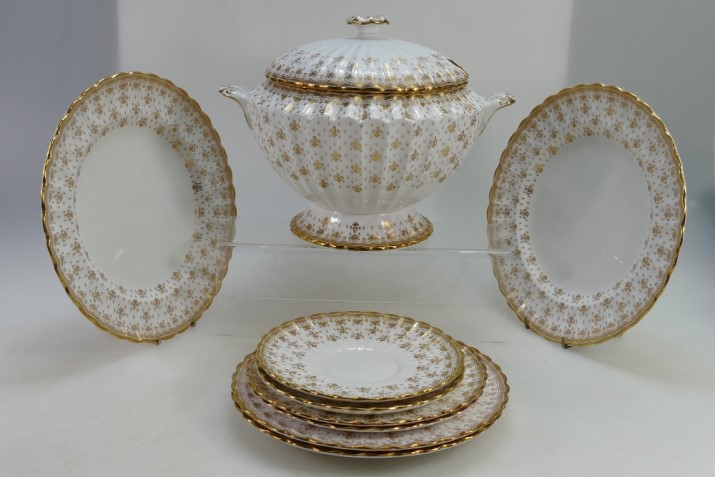
This stunning Spode dinner set is decorated with the popular Fleur de Lys Gold pattern and sold for a wonderful £160 at one of our Antique, Rare Pottery and Fine Art Sales.
Spode pottery is a household name. Representing quality and finesse, it’s sure to make any dining table sparkle, but how do you know if your Spode piece is genuine, how can you discover its true value? Here at Potteries Auctions, we can help.
We’ve created an extensive range of pottery markings guides, from Wedgewood and Royal Doulton to Wade Pottery. Our marking guides will help you identify the dates and potential value of your pottery, teaching you to spot rare and opulent pieces. We can then help you sell your own pottery, or we can help you add to your collection.
Keep reading to discover if your Spode pottery is a hidden gem.
What is the History of Spode Pottery?
The year 2020 marked the 250-year anniversary for Spode pottery, an incredible feat for any brand. From humble beginnings in 1770 to a global success, it goes to show the impact Spode pottery has had on British ceramics.
Founded in 1770 by Josiah Spode, the factory was set up in the heart of the Potteries – Stoke-on-Trent. Josiah Spode is most renowned for developing the specific design technique that meant underglaze transfers could be printed on earthenware.
Later focusing on the manufacturing of porcelain, Josiah Spode lead the way in the development of a new form of porcelain, originally calling it ‘Stoke China’, before establishing the name we know today, ‘Bone China’.
After his untimely and unexpected death in 1797, Josiah Spode’s son took over the family business and continued his father’s pursuit of quality ceramic development. You can read more about the history of Spode here.

A wonderfully rare find. this large and unused collection of Spode teaware and dinnerware, with the beautiful Ashdown pattern, sold for a spectacular £240 at one of our Antique, Rare Pottery and Fine Art Sale back in November 2018.
What Makes Spode Pottery Different?
Spode is still designed in Britain and has now become synonymous with British ceramics, so investing in Spode pottery can be a great decision.
What makes Spode pottery so different is the wonderful mix of past and modern-day design, bringing its own history to life whilst still creating timeless and classic pieces.
“We are motivated by a revolutionary spirit, one that inspires our modern collections whilst keeping our unique British heritage alive.” – Spode Pottery.

The Blue Italian pattern is possibly the most recognisable and timeless Spode design.
How Do I Know If My Spode Pottery is Valuable?
Depending on the age and markings of your Spode pottery there is a huge variation in its value. Our experts can help you discover the worth and desirability of your piece.
What Markings Should I Look for on Spode Pottery?
Some identifying features to look out for:
- Due to the long history of Spode, there are a variety of markings that showcase the varied ownership of the company. You’ll need to look out for the Copeland brand and Garret markings as well as the Spode name.
- Date Marks – These trademarks allow collectors to determine the approximate age of a piece and the time period it was produced. These were often impressed, giving you the month and year the piece was made. These can be a letter above two numbers or a series of letters. Robert Copeland’s ‘mark book’ can be a great place to start with identification.

The Tapestry Spode marking.
The Most Common Spode Markings
There have been hundreds of different backstamps used during the 250 years of Spode manufacturing. If you are unsure about the authenticity of a piece, it can be best to seek expert support.

This is an early painted backstamp c1807. When the company first started, pieces were not always marked and sometimes you’ll just find a pattern with no backstamp. It’s worth noting, though, that most painted marks are red, sometimes blue, or black was used too.

This marking is a printed backstamp c1835-45. During this time, Spode was known as ‘Copeland and Garrett’. This is an usual backstamp as it includes the ‘Japan Stone’, which was the name of the pottery.

This backstamp was used from c1880. During this time, Spode was managed by the Copeland Family ownership. You’ll often find Copeland on pieces from 1847-1970.

Moving forward to 1970, the brand name reverted back to Spode. The more recognisable branding is used and printed on pieces to this day. The logo was designed by John Sutherland Hawes.
Whilst the markings might appear confusing, our experts can help identify and value your pottery in no time at all and we can sell or value your Spode items.
Photo Credit: Spode History
Where to Sell Your Spode Pottery
If you are looking to buy or sell Spode pottery, collectables or dinner sets, our team of experts at Potteries Auctions can help. Potteries Auctions canidentify and provide valuations on a wide range of Spode pieces. Please get in touch with usto discuss how we can help you or request a call back if you are looking for an expert evaluation and are seeking to sell your Spode pottery.
